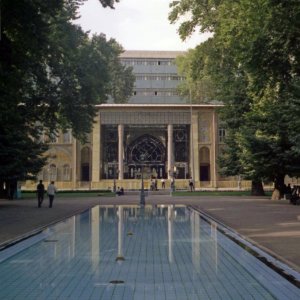Advertisement
Published: February 12th 2022

 Golestan Palace
Golestan Palace
Golestan Palace (Kakh-i Gulistan), Tehran, in 1971. View of the Marble Throne Building (Imarat-i Takht-i Marmar) of 1759 and reflecting pool. The Ministries of Finance and Justice are behind it.
Iran038p1In the summer of 1971 I traveled to Iran with the Los Angeles Geographical Society. A Pan Am flight took us from Los Angeles to London for a connecting BOAC flight on to Tehran. A long flight, but I was very much up for seeing this storied land. Upon leaving Mehrabad Airport for the transfer to downtown Tehran, the first sight to be seen was the then-new Shahyad Tower (now the Azadi Monument) constructed in a large traffic circle. The imposing monument had just been built to commemorate the 2,500th anniversary of the Persian Empire. Certainly it gave the observer the impression of permanence to the Palahvi dynasty.
First impressions were of the modernity one encountered in cosmopolitan downtown Tehran. An English-language newspaper carried ads for telephone answering machines. That was cutting edge technology in 1971. (I would not have one until a number of years in the future.) Men and women wore Western attire and women with veils or scarves were rarely seen in the city. The tall Alborz Mountains to the north and visible from all points were imposing--orders of magnitude larger that the San Gabriel Mountains I was accustomed to seeing from our living room window in

 LAGEOS Group in Tehran
LAGEOS Group in Tehran
I am the fourth from left.
Iran037Eagle Rock. Mount Tochal tops at 13,002 ft. (3963 m).
We drove to visit a village north of Tehran in the foothills. (It may have been Darband.) It was set in a hilly and rocky terrain (something like the California high desert). Tradition was more the rule here than in the city. Although the men generally wore short sleeve shirts or polos rather than traditional attire, full dark burqa for women was the rule. We visited the bazaar here, with all manner of produce and fruits, dry goods, and merchandise on display. Vendor stalls were both in an enclosed arcade and outside along the streets.
The microbus in which the group traveled was an Iranian built product. I observed it had an interesting manufacturer's logo--a horse pulling a chariot. (Cyrus' chariot? I learned later it was the logo of the Iran Khodro automotive group.) The guide was supportive of the Shah. (I suppose he had to be. Though this period was still some years before the Shah instituted one-party rule and Iran was considered a constitutional monarchy.) He spoke of how the Shah was trying to get more in touch with the people and had recently opened the

 Shahyad Tower
Shahyad Tower
Postcard of the Shahyad Tower in Shah Square. Completed in 1972. It is now known as the Azadi Tower. Iran102palace to a televised visit--something not done before. During the televised tour of the palace, the Shah had introduced his family. One item that impressed the guide about the TV program was that Shah introduced his son, Crown Prince Reza, (then 10) to the public by asking him to bring a book from the palace library
Advertisement
Tot: 0.048s; Tpl: 0.01s; cc: 12; qc: 29; dbt: 0.0228s; 1; m:domysql w:travelblog (10.17.0.13); sld: 1;
; mem: 1.1mb

 Golestan Palace
Golestan Palace
 LAGEOS Group in Tehran
LAGEOS Group in Tehran
 Shahyad Tower
Shahyad Tower
